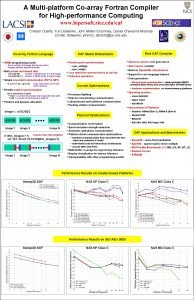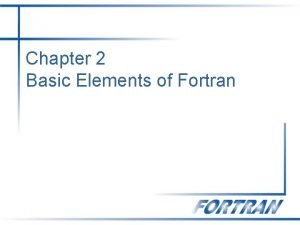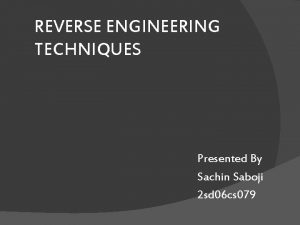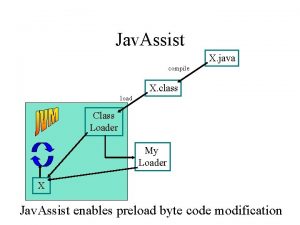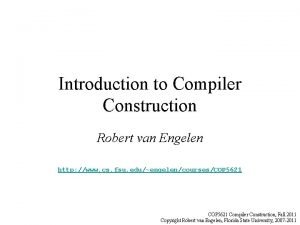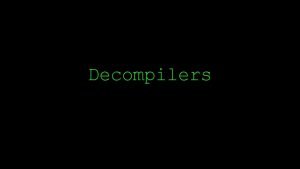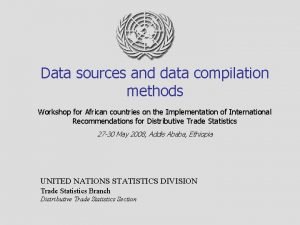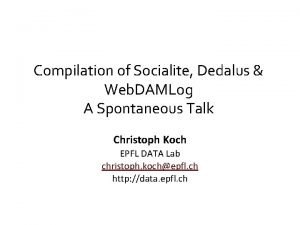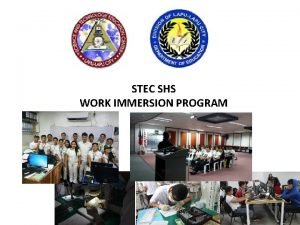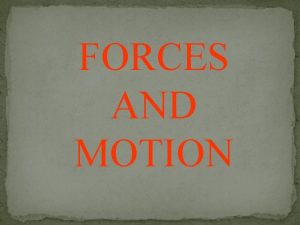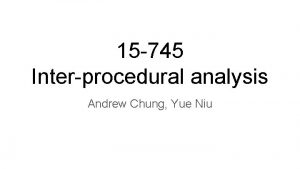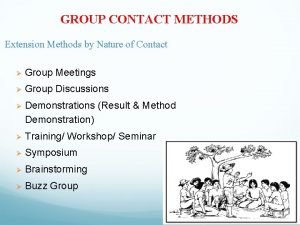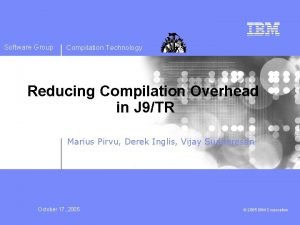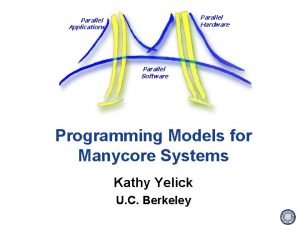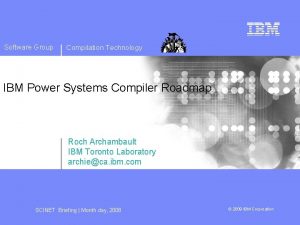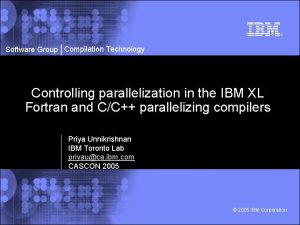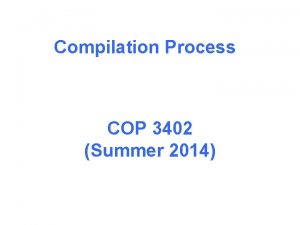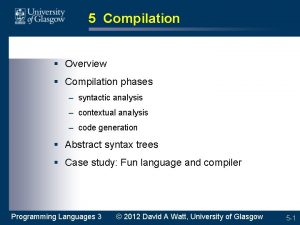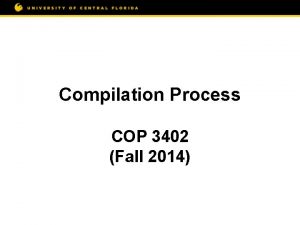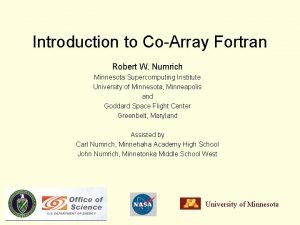Software Group Compilation Technology Coarray a parallel extension



![Software Group Compilation Technology Coarray background Proposed by Numrich and Reid [1998] Natural extension Software Group Compilation Technology Coarray background Proposed by Numrich and Reid [1998] Natural extension](https://slidetodoc.com/presentation_image/dc4505c2e694063f6bedaa78c70304db/image-4.jpg)

![Software Group Compilation Technology Coarray syntax CODIMENSION attribute double precision, dimension(2, 2), CODIMENSION[*] : Software Group Compilation Technology Coarray syntax CODIMENSION attribute double precision, dimension(2, 2), CODIMENSION[*] :](https://slidetodoc.com/presentation_image/dc4505c2e694063f6bedaa78c70304db/image-6.jpg)











- Slides: 17

Software Group Compilation Technology Coarray: a parallel extension to Fortran Jim Xia IBM Toronto Lab jimxia@ca. ibm. com SCINET compiler workshop | February 17 -18, 2009 © 2009 IBM Corporation

Software Group Compilation Technology Agenda Coarray background Programming model Synchronization Comparing coarrays to UPC and MPI Q&A 2 SCINET compiler workshop | coarray Fortran © 2009 IBM Corporation

Software Group Compilation Technology Existing parallel model MPI: de facto standard on distributed memory systems Difficult to program Open. MP: popular on shared memory Lack of data locality control Not designed for distributed systems 3 SCINET compiler workshop | coarray Fortran © 2009 IBM Corporation
![Software Group Compilation Technology Coarray background Proposed by Numrich and Reid 1998 Natural extension Software Group Compilation Technology Coarray background Proposed by Numrich and Reid [1998] Natural extension](https://slidetodoc.com/presentation_image/dc4505c2e694063f6bedaa78c70304db/image-4.jpg)
Software Group Compilation Technology Coarray background Proposed by Numrich and Reid [1998] Natural extension of Fortran's array language Originally named F-- (as jokey reference to C++) One of the Partitioned Global Address Space languages (PGAS) Other GAS languages: UPC and Titanium Benefits One-sided communication User controlled data distribution and locality Suitable for a variety of architectures: distributed, shared or hybrid Standardized as a part of Fortran 2008 Expected to be published in 2010 SCINET compiler workshop | coarray Fortran © 2009 IBM Corporation

Software Group Compilation Technology Programming model Single Program Multiple Data (SPMD) Fixed number of processes (images) “Everything is local!” [Numerich] All data is local All computation is local Explicit data partition with one-sided communication Remote data movement through codimensions Programmer explicitly controls the synchronizations Good or bad? SCINET compiler workshop | coarray Fortran © 2009 IBM Corporation
![Software Group Compilation Technology Coarray syntax CODIMENSION attribute double precision dimension2 2 CODIMENSION Software Group Compilation Technology Coarray syntax CODIMENSION attribute double precision, dimension(2, 2), CODIMENSION[*] :](https://slidetodoc.com/presentation_image/dc4505c2e694063f6bedaa78c70304db/image-6.jpg)
Software Group Compilation Technology Coarray syntax CODIMENSION attribute double precision, dimension(2, 2), CODIMENSION[*] : : x or simply use [ ] syntax double precision : : x(2, 2)[*] a coarray can have a corank higher than 1 ● double precision : : A(100, 100)[5, *] from ANY single image, one can refer to the array x on image Q using [ ] X(: , : )[Q] e. g. Y(: , : ) = X(: , : )[Q] X(2, 2)[Q] = Z Coindexed objects Normally the remote data Without [ ] the data reference is local to the image ● X(1, 1) = X(2, 2)[Q] ● !LHS is local data; RHS is a coindexed object, likely a ● !remote data SCINET compiler workshop | coarray Fortran © 2009 IBM Corporation

Software Group Compilation Technology Coarray memory model x(1, 1) x(1, 2) x(1, 1) x(1, 2) x(2, 1) x(2, 2) x(2, 1) x(2, 2) Image 1 Image 2 Image p Image q Image n Logical view of coarray X(2, 2)[*] A fixed number of images during execution Each has a local array of shape (2 x 2) examples of data access: local data and remote data X(1, 1) = X(2, 2)[q] !assignment occurs on all images if (this_image() == 1) X(2, 2)[q] = SUM(X(2, : )[p]) !computation of SUM occurs on image 1 SCINET compiler workshop | coarray Fortran © 2009 IBM Corporation

Software Group Compilation Technology Example: circular shift by 1 x(2: n-1) X (N) Image 1 Left Me Right x(2: n-1) X (N) Image T Real : : X(N)[*] image indexing me = this_image() if (me == 1) then left = num_images() else left = me - 1 end if Execute the shift SYNC ALL temp = x(n-1) x(2: n-1) = x(1: n-2) x(1) = x(n)[left] SYNC ALL x(n) = temp SCINET compiler workshop | coarray Fortran “Global view” on coarray Fortran intrinsic CSHIFT only works on local arrays this_image(): index of the executing image num_images(): the total number of images © 2009 IBM Corporation

Software Group Compilation Technology Synchronization primitives Multi-image synchronization SYNC ALL Synchronization across all images SYNC IMAGES Synchronization on a list of images Memory barrier SYNC MEMORY Image serialization CRITICAL (“the big hammer”) Allows one image to execute the block at a time LOCK: provide fine-grained disjoint data access Simple lock support Some statements may imply synchronization SYNC ALL implied when the application starts SCINET compiler workshop | coarray Fortran © 2009 IBM Corporation

Software Group Compilation Technology Example: SYNC IMAGES Master image to distribute and collect data distribute data (Wait for data) sync images (*) sync images (1) Perform task sync images (*) sync images (1) Other work collect data perform IO Image 1 Image p if (this_image() == 1) then call distribute. Data () SYNC IMAGES (*) call perform. Task () SYNC IMAGES (*) call collect. Data () call perform. IO () else SYNC IMAGES (1) call perform. Task () SYNC IMAGES (1) call other. Work () end if SCINET compiler workshop | coarray Fortran Image q Image n Good: Image q starts perform. Task once its own data are set – no wait for image p Works well on a balanced system Bad if the load is not balanced Efficient if collaboration among small set of images © 2009 IBM Corporation

Software Group Compilation Technology Atomic load and store Two atomic operations provided for spin-lock-loop ATOMIC_DEFINE and ATOMIC_REF LOGICAL(ATOMIC_LOGICAL_KIND), SAVE : : LOCKED[*] =. TRUE. LOGICAL : : VAL INTEGER : : IAM, P, Q IAM = THIS_IMAGE() IF (IAM == P) THEN ! preceding work SYNC MEMORY CALL ATOMIC_DEFINE (LOCKED[Q], . FALSE. ) SYNC MEMORY ELSE IF (IAM == Q) THEN VAL =. TRUE. DO WHILE (VAL) CALL ATOMIC_REF (VAL, LOCKED) END DO SYNC MEMORY ! Subsequent work END IF SCINET compiler workshop | coarray Fortran © 2009 IBM Corporation

Software Group Compilation Technology CAF implementation and Performance studies Existing coarray implementations Cray Rice University G 95 Coarray applications Most on large distributed systems e. g. ocean modeling Performance evaluation A number of performance studies have been done CAF Fortran 90 + MPI IBM is implementing coarrays CAF and UPC on a common run-time SCINET compiler workshop | coarray Fortran © 2009 IBM Corporation

Software Group Compilation Technology Standardization status Coarray is in base language of Fortran 2008 Could be finalized this May Standard to be published in 2010 Fortran to be the first general purpose language to support parallel programming The coarray TR (future coarray features) TEAM and collective subroutines More synchronization primitives notify / query (point – to – point) Parallel IO: multiple images on same file SCINET compiler workshop | coarray Fortran © 2009 IBM Corporation

Software Group Compilation Technology Comparison between CAF and UPC CAF : REAL : : X(2)[*] X (1) X (2) Image 1 . . . X (1) X (2) Image 2 Image num_images() UPC : shared [2] float x[2*THREADS] x [0] x [2] x [1] x [3] Thread 0 . . . x[2*THREADS-2] x[2*THREADS-1] Thread 1 Thread THREADS-1 SCINET compiler workshop | coarray Fortran © 2009 IBM Corporation

Software Group Compilation Technology Coarrays and MPI Early experience demonstrated coarrays and MPI can coexist in the same application Migration from MPI to coarray has shown some success Major obstacle: CAF is not widely available Fortran J 3 committee willing to work with MPI forum Two issues Fortran committee is currently working on to support: C interop with void * buf; (C) TYPE(*), dimension(. . . ) : : buf (Fortran) MPI nonblocking calls: MPI_ISEND, MPI_IRECV and MPI_WAIT SCINET compiler workshop | coarray Fortran © 2009 IBM Corporation

Software Group Compilation Technology Example: comparing CAF to MPI: if (master) then r(1) = reynolds. . . r(18) = viscosity call mpi_bcast(r, 18, real_mp_type, masterid, MPI_comm_world, ierr) else call mpi_bcast(r, 18, real_mp_type, masterid, MPI_comm_world, ierr) reynolds = r(1). . . viscosity = r(18) endif (Ashby and Reid, 2008) SCINET compiler workshop | coarray Fortran CAF: sync all if (master) then do i=1, num_images()-1 reynolds[i] = reynolds. . . viscosity[i] = viscosity end do end if sync all Or simply: sync all reynolds = reynolds[masterid]. . . viscosity = viscosity[masterid] © 2009 IBM Corporation

Software Group Compilation Technology Q&A SCINET compiler workshop | coarray Fortran © 2009 IBM Corporation
 Coarray fortran tutorial
Coarray fortran tutorial Coarray fortran tutorial
Coarray fortran tutorial Brand leveraging strategies
Brand leveraging strategies Phases of reverse engineering
Phases of reverse engineering Jav adaptation
Jav adaptation What is pure and impure interpreter
What is pure and impure interpreter Analysis synthesis model of compilation
Analysis synthesis model of compilation Front end vs back end compiler
Front end vs back end compiler Reverse compilation
Reverse compilation Contoh compilation
Contoh compilation What is data compilation
What is data compilation Hotinpl
Hotinpl Compilation of quran
Compilation of quran Compilation of work in work immersion
Compilation of work in work immersion Sangrihitri during the vedic age was
Sangrihitri during the vedic age was Bus crash compilation
Bus crash compilation Previous ipdb not found, fall back to full compilation.
Previous ipdb not found, fall back to full compilation. Contact methods
Contact methods
